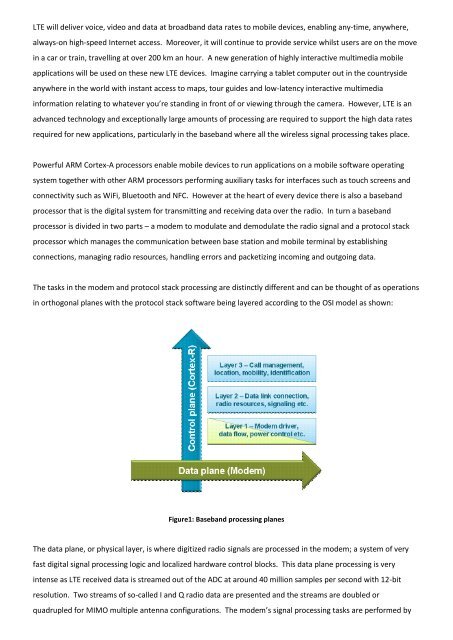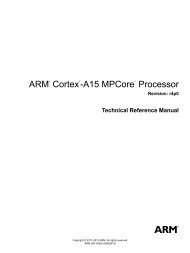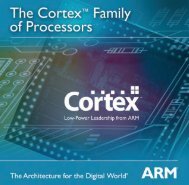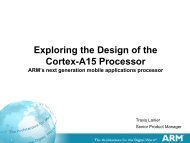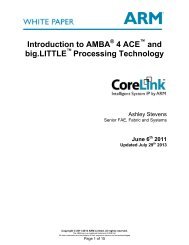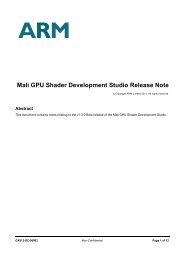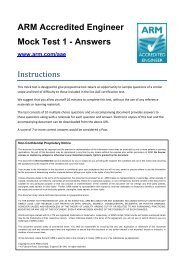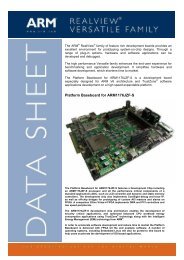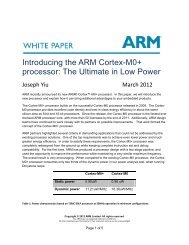New Cortex-R Processors for LTE and 4G Mobile Baseband - ARM
New Cortex-R Processors for LTE and 4G Mobile Baseband - ARM
New Cortex-R Processors for LTE and 4G Mobile Baseband - ARM
- No tags were found...
You also want an ePaper? Increase the reach of your titles
YUMPU automatically turns print PDFs into web optimized ePapers that Google loves.
<strong>LTE</strong> will deliver voice, video <strong>and</strong> data at broadb<strong>and</strong> data rates to mobile devices, enabling any-time, anywhere,always-on high-speed Internet access. Moreover, it will continue to provide service whilst users are on the movein a car or train, travelling at over 200 km an hour. A new generation of highly interactive multimedia mobileapplications will be used on these new <strong>LTE</strong> devices. Imagine carrying a tablet computer out in the countrysideanywhere in the world with instant access to maps, tour guides <strong>and</strong> low-latency interactive multimediain<strong>for</strong>mation relating to whatever you’re st<strong>and</strong>ing in front of or viewing through the camera. However, <strong>LTE</strong> is anadvanced technology <strong>and</strong> exceptionally large amounts of processing are required to support the high data ratesrequired <strong>for</strong> new applications, particularly in the baseb<strong>and</strong> where all the wireless signal processing takes place.Powerful <strong>ARM</strong> <strong>Cortex</strong>-A processors enable mobile devices to run applications on a mobile software operatingsystem together with other <strong>ARM</strong> processors per<strong>for</strong>ming auxiliary tasks <strong>for</strong> interfaces such as touch screens <strong>and</strong>connectivity such as WiFi, Bluetooth <strong>and</strong> NFC. However at the heart of every device there is also a baseb<strong>and</strong>processor that is the digital system <strong>for</strong> transmitting <strong>and</strong> receiving data over the radio. In turn a baseb<strong>and</strong>processor is divided in two parts – a modem to modulate <strong>and</strong> demodulate the radio signal <strong>and</strong> a protocol stackprocessor which manages the communication between base station <strong>and</strong> mobile terminal by establishingconnections, managing radio resources, h<strong>and</strong>ling errors <strong>and</strong> packetizing incoming <strong>and</strong> outgoing data.The tasks in the modem <strong>and</strong> protocol stack processing are distinctly different <strong>and</strong> can be thought of as operationsin orthogonal planes with the protocol stack software being layered according to the OSI model as shown:Figure1: Baseb<strong>and</strong> processing planesThe data plane, or physical layer, is where digitized radio signals are processed in the modem; a system of veryfast digital signal processing logic <strong>and</strong> localized hardware control blocks. This data plane processing is veryintense as <strong>LTE</strong> received data is streamed out of the ADC at around 40 million samples per second with 12-bitresolution. Two streams of so-called I <strong>and</strong> Q radio data are presented <strong>and</strong> the streams are doubled orquadrupled <strong>for</strong> MIMO multiple antenna configurations. The modem’s signal processing tasks are per<strong>for</strong>med by


